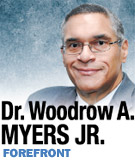Subscriber Benefit
As a subscriber you can listen to articles at work, in the car, or while you work out. Subscribe Now
 It was the worst pain I can remember. It awoke me from a sound sleep. I had to throw all the big-gun pain relievers at it—and they barely made a dent. I was able to walk and to talk and point with one finger to the exact spot that was killing me.
It was the worst pain I can remember. It awoke me from a sound sleep. I had to throw all the big-gun pain relievers at it—and they barely made a dent. I was able to walk and to talk and point with one finger to the exact spot that was killing me.
Although in a different geography, this had to be worse than childbirth. I am a grown man, who liked to think of himself as courageous and brave and strong—but alas I was cut down to size, whimpering, almost reduced to tears—for I had developed one hell of a toothache.
And I knew the next step. I needed a treatment first confirmed in the remains of a Nabatean warrior buried in the Negev desert 2,200 years ago. It is a treatment that evokes strong emotions and on occasion great fear. It is not something any nice person wishes for another nice person (unless you happen to be an endodontist).
I needed a root canal. And all I could imagine was Steve Martin as Dr. Orin Scrivello, the sadistic (yet insanely funny) dentist in the movie “The Little Shop of Horrors.” Thank goodness my dentists are at Indiana University.
Toothaches can occur for a number of reasons; in my case, there was damage to one of my molars many years ago and over time bacteria crept into the nerve in the canals inside the tooth. The nerve irritation and infection in a confined space was the source of my pain and that of millions of us every month of every year.
In the old days, if you were lucky enough to find a barber (yes, a barber), dentist or doctor willing to help, your procedure could involve several swigs of whiskey (to mask the fear and pain) and a couple of muscular “dental assistants” to hold you down while a strong thread was attached to the tooth and a doorknob. The door was then slammed with as much force as humanly possible. Or it could be tied to a horse who was then encouraged to run at full speed.
Fortunately, times have changed. Today, after anesthesia, the canals holding the diseased roots are exposed, the roots are removed, and the canals are cleaned and filled so future problems are avoided.
We are so lucky in Indiana to have the IU School of Dentistry, clearly one of the world’s best dental schools. The faculty has trained over 11,000 alumni who are engaged in clinical dentistry in more than 30 countries. The university is the home of Crest toothpaste, where scientists figured out how to use stannous fluoride to prevent tooth decay. IU is also a world leader in community dentistry, where outreach to underserved areas and to children with special needs has improved the public’s health around the globe.
At the dental school, a root canal is a beautiful dance of science and art. After taking my history, performing an examination, and a computerized X-ray, my surgical assistants, resident dentist and attending dentist (all highly professional, empathetic women) put me at ease, told me everything they were about to do, and went to work.
Pain from the procedure? Virtually none. The worst part of the treatment was the high-pitched noise of the drill used to access the canals. I characterized the sound as that of an energetic and aroused male dolphin reaching the critical moment.
About an hour later, the IU professionals were done. Before I left, I had a full-mouth, three-dimensional computerized tomographic scan (which took all of 30 seconds with exceptionally low radiation exposure) to determine the bone density and the exact location of my defect so the crown to protect the tooth could be custom-crafted for an exact fit on my next visit.
Wow. We’ve come a long way from a shot of Old Grand-Dad and a pair of pliers.•
__________
Myers is a former chief medical officer for WellPoint Inc. and served as health commissioner for Indiana and New York City. Send comments on this column to [email protected].
Please enable JavaScript to view this content.
